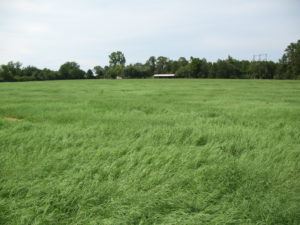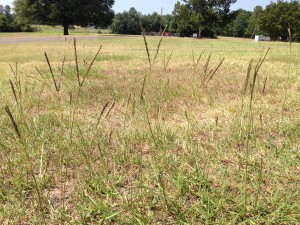Forage systems are essential for the livestock industry, and the selection of the right grass species is crucial for optimal animal performance. Bermudagrass and bahiagrass are introduced summer perennial grasses that are well adapted to Central and East Texas.
Hybrid bermudagrass is a highly productive, warm season grass that grows well in areas with mild winters and long, hot summers. It has a fine stem and leaf structure, making it a highly palatable forage option for livestock. Hybrid bermudagrass is known for it’s high yield potential and nutrient density, making it a valuable option for grazing and hay production. Bahiagrass is another warm season grass that is commonly used in forage systems. It is a hardy grass that grows well in sandy soils and low fertility conditions relative to bermudagrass. Both of these grasses are important to many East Texas forage systems, but they do have unique characteristics that make them suitable for different environments and conditions. There are several factors producers should consider when deciding which of these grasses is best for their farm, such as forage establishment requirements, inputs required to sustain forage once established, quantity of production, and quality of forage produced.
In terms of ease of establishment and input requirements bermudagrass tends to require more inputs and maintenance than bahiagrass. Satisfactory stands of bahiagrass can be achieved by broadcasting into a prepared seedbed or drilling seed into the ground in April or May after the last freeze. Texas A&M AgriLife Extension bahiagrass seeding rates vary between 8-20 lbs PLS/acre based on variety and method of seeding utilized. In contrast to bahiagrass, hybrid bermudagrass should be sprigged at a rate of 30-40 bushels of fresh sprigs per acre. Sprigs can be planted in a prepared seedbed from January (dormant sprigs) to July as long as there is sufficient moisture in the soil.
Input requirements to sustain the forage after the grass has been established is another key difference between these two grasses. Hybrid bermudagrass requires regular fertilization and pesticide applications for control of pests such as the bermudagrass stem maggot, armyworms and grasshoppers to maintain high productivity levels. Bahiagrass, on the other hand, does respond well to fertilizer applications, but is a lower maintenance forage that can tolerate lower fertility conditions. The three pests that occasionally cause issues in bahiagrass stands are fall armyworms, grasshoppers and mole crickets.
In terms of yield potential, hybrid bermudagrass has a more aggressive growth habit than bahiagrass that enables it to produce large quantities of hay. Texas A&M AgriLife Research has shown the highest yielding hybrid bermudagrass cultivar, Tifton 85, yields approximately 5,000 pounds per acre more than the highest yielding bahiagrass variety, Tifton 9. Cultivars of hybrid bermudagrass such as Tifton 85 can be successfully managed for grazing or hay production due to its high yield potential. Bahiagrass has a slightly slower growth rate and is better suited for more moderate input grazing systems.
Forage quality is another area that hybrid bermudagrass holds a slight edge over bahiagrass. Hybrid bermudagrass has a higher nutrient density than bahiagrass, containing more energy and better digestibility. It is important to always test stored forages, as there are numerous factors that do impact quality and could cause quality to fall outside of typical ranges.
In summary, both hybrid bermudagrass and bahiagrass have their benefits and drawbacks in forage systems. Ultimately, the choice of grass species depends on the specific needs and management goals of the forage system. For more information on selecting the best forage for your operation, contact your local County Extension Agent.
Vanessa Corriher-Olson, Ph.D.
Professor, Forage Extension Specialist
Texas A&M AgriLife Extension
Soil & Crop Sciences
Overton, TX

